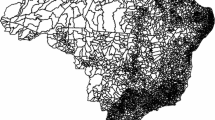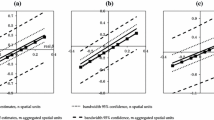Abstract
This paper sets forth an approach which allows for dealing with both model uncertainty and threshold effects of unknown form in spatial growth regression models. The estimation of threshold effects designates different spatial growth regimes which account for unknown structural heterogeneities in the parameter estimates. Using stochastic search variable selection priors, the paper deals with the issue of model uncertainty in a flexible and computationally efficient way. The paper uses Bayesian Markov chain Monte Carlo to simultaneously account for threshold effects, model uncertainty, and spatial dependence in regional growth regression models. The approach is illustrated for both identifying model covariates and unveiling growth regimes present in pan-European growth data.

Similar content being viewed by others
Notes
For specifics on Markov chain Monte Carlo (MCMC) estimation in general, see Koop (2003).
It is worth noting that a diffuse prior specification like in Eq. (23) might result in a growth regime that consists of less observations/regions than explanatory variables, which in turn impedes the identifiability of the model. This concern can be eased by using rejection sampling, which involves simply discarding the respective draws for \({\omega _t}\).
The sample regions include regions located in Austria (nine regions), Belgium (11 regions), Bulgaria (six regions), Czech Republic (eight regions), Denmark (five regions), Estonia (one region), Finland (five regions), France (22 regions), Germany (38 regions), Greece (13 regions), Hungary (seven regions), Italy (21 regions), Latvia (one region), Lithuania (one region), Luxembourg (one region), Netherlands (12 regions), Norway (seven regions), Poland (16 regions), Portugal (five regions), Republic of Ireland (two regions), Romania (eight regions), Slovakia (four regions), Slovenia (two regions), Spain (16 regions), Sweden (eight regions), Switzerland (seven regions), and the UK (37 regions).
ISCED refers to the International Standard Classification of Education.
Robustness checks using different values of k barely affected the results. Results for different number of nearest neighbors are available upon request.
It is, moreover, worth noting that model specifications for \(M>2\) produce very imprecise parameter estimates, since the number of parameters gets very large relative to n. Results for alternative choices of M and \({\varvec{z}}\) are available upon request.
For a detailed discussion on the interpretation of parameter estimates in spatial autoregressive models, see LeSage and Pace (2009).
References
Alfo M, Trovato G, Waldmann RJ (2008) Testing for country heterogeneity in growth models using a finite mixture approach. J Appl Econ 23(4):487–514
Azariadis C, Drazen A (1990) Threshold externalities in economic development. Q J Econ 105(2):501–526
Azomahou T, Mishra T (2008) Age dynamics and economic growth: revisiting the nexus in a nonparametric setting. Econ Lett 99(1):67–71
Barro RJ (1991) Economic growth in a cross section of countries. Q J Econ 106(2):407–443
Battisti M, De Vaio G (2008) A spatially filtered mixture of \(\beta \)-convergence regressions for EU regions, 1980–2002. Empir Econ 34(1):105–121
Baumol WJ (1986) Productivity growth, convergence, and welfare: what the long-run data show. Am Econ Rev 76(5):1072–1085
Boucekkine R, De la Croix D, Licandro O (2002) Vintage human capital, demographic trends, and endogenous growth. J Econ Theory 104(2):340–375
Brock W, Durlauf S (2001) Growth empirics and reality. World Bank Econ Rev 15(2):229–272
Canova F (2004) Testing for convergence clubs in income per capita: a predictive density approach. Int Econ Rev 45(1):49–77
Chen CW (1998) A Bayesian analysis of generalized threshold autoregressive models. Stat Prob Lett 40(1):15–22
Chen CW, Liu FC, Gerlach R (2011) Bayesian subset selection for threshold autoregressive moving-average models. Comput Stat 26(1):1–30
Chen CW, So MK, Gerlach RH (2005) Assessing and testing for threshold nonlinearity in stock returns. Aust N Z J Stat 47(4):473–488
Chib S (1995) Marginal likelihood from the Gibbs output. J Am Stat Assoc 90(432):1313–1321
Chib S, Jeliazkov I (2001) Marginal likelihood from the Metropolis–Hastings output. J Am Stat Assoc 96(453):270–281
Cuaresma JC, Doppelhofer G (2007) Nonlinearities in cross-country growth regressions: a Bayesian averaging of thresholds (BAT) approach. J Macroecon 29(3):541–554
Cuaresma JC, Doppelhofer G, Feldkircher M (2014) The determinants of economic growth in European regions. Reg Stud 48(1):44–67
Cuaresma JC, Feldkircher M (2013) Spatial filtering, model uncertainty and the speed of income convergence in Europe. J Appl Econom 28(4):720–741
Durlauf SN, Johnson PA (1995) Multiple regimes and cross-country growth behaviour. J Appl Econom 10(4):365–384
Egger P, Pfaffermayr M (2006) Spatial convergence. Pap Reg Sci 85(2):199–215
Eicher TS, Papageorgiou C, Roehn O (2007) Unraveling the fortunes of the fortunate: an iterative Bayesian model averaging (IBMA) approach. J Macroecon 29(3):494–514
Ertur C, Koch W (2007) Growth, technological interdependence and spatial externalities: theory and evidence. J Appl Econom 22(4):1033–1062
Ertur C, Le Gallo J, LeSage JP (2007) Local versus global convergence in Europe: a Bayesian spatial econometric approach. Rev Reg Stud 37(1):82–208
Fernández C, Ley E, Steel MF (2001a) Benchmark priors for Bayesian model averaging. J Econom 100(2):381–427
Fernández C, Ley E, Steel MF (2001b) Model uncertainty in cross-country growth regressions. J Appl Econom 16(5):563–576
Fingleton B (2001) Theoretical economic geography and spatial econometrics: dynamic perspectives. J Econ Geogr 1(2):201–225
Fingleton B, López-Bazo E (2006) Empirical growth models with spatial effects. Pap Reg Sci 85(2):177–198
Fischer MM, LeSage JP (2014) A Bayesian space-time approach to identifying and interpreting regional convergence clubs in Europe. Pap Reg Sci. doi:10.1111/pirs.12104
Fischer MM, Stirböck C (2006) Pan-European regional income growth and club-convergence. Ann Reg Sci 40(4):693–721
Galor O (1996) Convergence? Inferences from theoretical models. Econ J 106(437):1056–1069
George EI, McCulloch RE (1993) Variable selection via Gibbs sampling. J Am Stat Assoc 88(423):881–889
George EI, McCulloch RE (1997) Approaches for Bayesian variable selection. Stat Sin 7(2):339–373
Getis A, Griffith DA (2002) Comparative spatial filtering in regression analysis. Geogr Anal 34(2):130–140
Geweke J (1992) Evaluating the accuracy of sampling-based approaches to the calculation of posterior moments. In: Bernardo JM, Berger JO, Dawid AP, Smith AFM (eds) Bayesian statistics 4. Oxford University Press, Oxford, pp 167–193
Geweke J (1993) Bayesian treatment of the independent student-t linear model. J Appl Econom 8(1):19–40
Hansen BE (2000) Sample splitting and threshold estimation. Econometrica 68(3):575–603
Hoeting JA, Madigan D, Raftery AE, Volinsky CT (1999) Bayesian model averaging: a tutorial. Stat Sci 14(4):382–417
Koop G (2003) Bayesian econometrics. Wiley, Chichester
Koop G, Potter S (2010) A flexible approach to parametric inference in nonlinear and time varying time series models. J Econom 159(1):134–150
Le Gallo J, Dall’Erba S (2008) Spatial and sectoral productivity convergence between European regions, 1975–2000. Pap Reg Sci 87(4):505–525
LeSage J, Pace R (2009) Introduction to spatial econometrics. CRC Press, Boca Raton
LeSage JP (1997) Bayesian estimation of spatial autoregressive models. Int Reg Sci Rev 20(1–2):113–129
LeSage JP, Fischer M (2008) Spatial growth regressions, model specification, estimation, and interpretation. Spat Econ Anal 3(3):275–304
LeSage JP, Parent O (2007) Bayesian model averaging for spatial econometric models. Geogr Anal 39(3):241–267
Lin X, Lee LF (2010) GMM estimation of spatial autoregressive models with unknown heteroskedasticity. J Econom 157(1):34–52
López-Bazo E, Vayá E, Artís M (2004) Regional externalities and growth: evidence from European regions. J Reg Sci 44(1):43–73
Mankiw NG, Romer D, Weil DN (1992) A contribution to the empirics of economic growth. Q J Econ 107:407–437
Masanjala WH, Papageorgiou C (2004) The solow model with CES technology: nonlinearities and parameter heterogeneity. J Appl Econom 19(2):171–201
Pace RK, LeSage JP, Zhu S (2013) Interpretation and computation of estimates from regression models using spatial filtering. Spat Econ Anal 8(3):352–369
Piribauer P, Fischer MM (2015) Model uncertainty in matrix exponential spatial growth regression models. Geogr Anal 47(3):240–261
Postiglione P, Benedetti R, Lafratta G (2010) A regression tree algorithm for the identification of convergence clubs. Comput Stat Data Anal 54(11):2776–2785
Raftery AE (1995) Bayesian model selection in social research. Sociol Methodol 25:111–163
Raftery AE, Lewis S (1992) How many iterations in the Gibbs sampler. In: Bernardo JM, Berger JO, Dawid AP, Smith AFM (eds) Bayesian statistics 4. Oxford University Press, Oxford, pp 763–773
Rey SJ, Montouri BD (1999) US regional income convergence: a spatial econometric perspective. Reg Stud 33(2):143–156
Sala-i-Martin X, Doppelhofer G, Miller RI (2004) Determinants of long-term growth: a Bayesian averaging of classical estimates (BACE) approach. Am Econ Rev 94:813–835
Schwarz G (1978) Estimating the dimension of a model. Ann Stat 6(2):461–464
Smith TE, LeSage JP (2004) A Bayesian probit model with spatial dependencies. Adv Econom 18:127–160
So MK, Chen CW (2003) Subset threshold autoregression. J Forecast 22(1):49–66
Author information
Authors and Affiliations
Corresponding author
Rights and permissions
About this article
Cite this article
Piribauer, P. Heterogeneity in spatial growth clusters. Empir Econ 51, 659–680 (2016). https://doi.org/10.1007/s00181-015-1023-y
Received:
Accepted:
Published:
Issue Date:
DOI: https://doi.org/10.1007/s00181-015-1023-y




